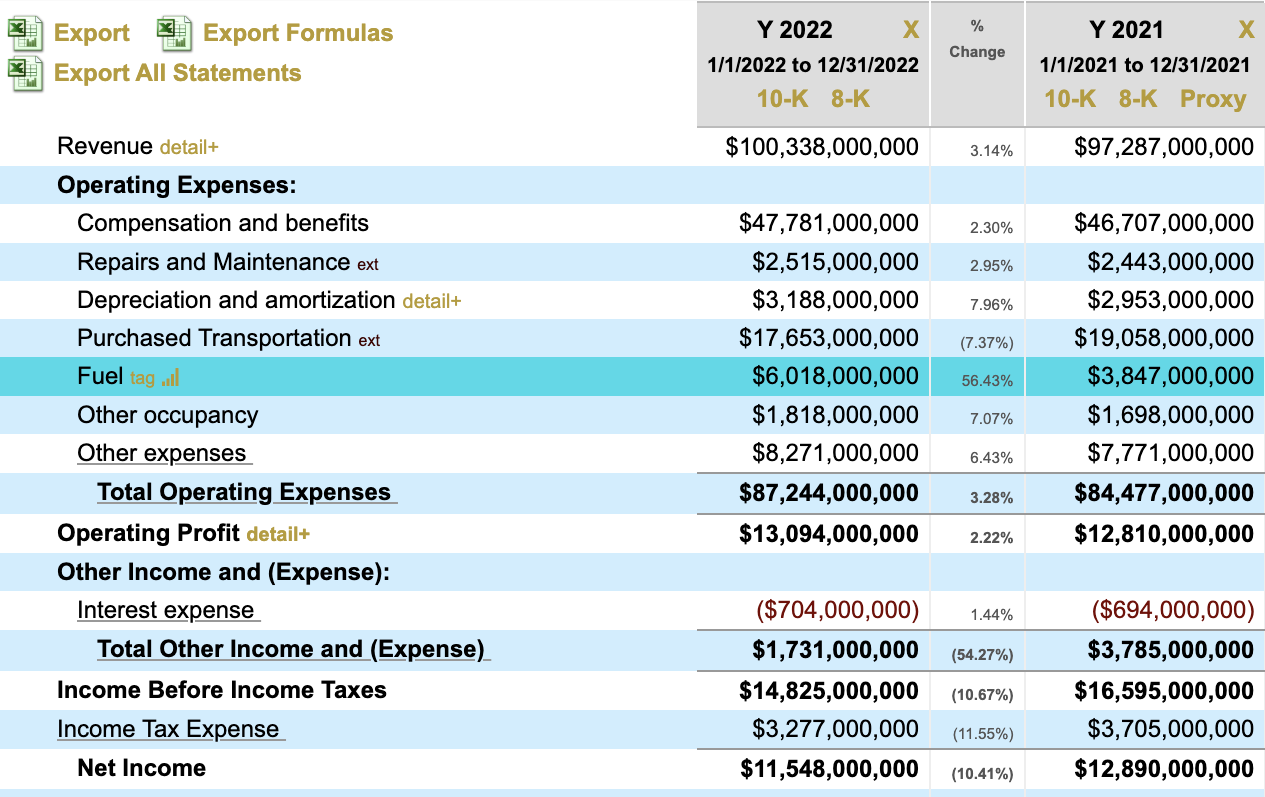Calcbench loves getting lost in the data, and today delivery giant UPS ($UPS) gave us an excellent example of how to do just that with its disclosures about financial performance and fuel costs.
First let’s look at the headline numbers, which are underwhelming at best. In its 2022 report filed this morning, UPS reported revenue of $100.34 billion. That’s an increase of 3.14 percent from one year ago — but once we start looking further down the income statement, the picture gets rather ugly.
Total operating expenses rose 3.3 percent to $87.24 billion, so operating profit only squeaked up 2.2 percent. UPS also reported $2.2 billion less in the ever-hand “other income” line, so the company’s pretax income, net income, and EPS were all down more than 10 percent from year-ago numbers. Yuck.
Still, we wanted to investigate UPS’ fuel costs because (1) they’re a significant expense for transportation-heavy businesses such as a shipping company; and (2) they can tell analysts a lot about where inflation might be going in quarters to come. So we opened our Interactive Disclosure tool and simply searched for “fuel.”
We found two important tidbits.
First, UPS imposed a fuel surcharge on customers for 2022, and while we don’t know exactly how much revenue that surcharge brought in for UPS, the company did say the increase in surcharge revenue was $3 billion. So UPS’ entire revenue growth for last year (from $97 billion to $100 billion) can be attributed to its fuel surcharge alone.
Second, that surcharge adjusts weekly, based on commodity energy prices — and those prices have been falling steadily after reaching a peak in mid-2022. Hence UPS added this disclosure in the Management Discussion & Analysis that seems important: “We expect a reduction in fuel surcharge revenue in 2023 based on the current commodity market outlook.” Well, given that fuel surcharges accounted for all of UPS’ revenue growth in 2022, what are the implications of that decline for UPS’ overall revenue picture in 2023?
We know some of you will immediately say, “Wait! If fuel costs decline, that means UPS’s operating expenses will decline, and that will cancel out the decline in fuel surcharge revenue!” Perhaps not. Look at Figure 1, below.

Fuel expenses only rose $2.171 billion from 2021 to 2022. So that $3 billion increase in fuel surcharge revenue last year was more than the increased fuel costs, and the $829 million difference was gravy that could fall to UPS’ bottom line. There’s nothing to say that equation can’t run in reverse: UPS sees lower fuel costs and lower fuel surcharge revenues, but also less gravy too.
Rival shipping giant FedEx ($FDX) also imposes a fuel surcharge, and the company did say in its most recent 10-K that fuel costs “had a significant benefit to operating income in 2022 as higher fuel surcharges outpaced increased fuel prices.”
Except, FedEx doesn’t disclose any specific dollar amounts like UPS does, and FedEx’s fiscal year ends on May 31 — and at that time in 2022, fuel costs were sky high. So we won’t have any update at all on FedEx’s fuel costs until sometime this summer, and even then we might not be able to ask the same questions that arise from UPS’s disclosures.
Filed under: food (or fuel) for thought.